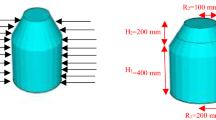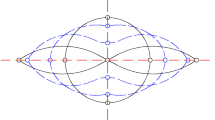Abstract
This paper presents the results of an experimental study on the buckling of scaled-down models of the inner vessel used in nuclear reactor structures. The inner vessel, a shell of composite geometry, consists of two cylindrical shells connected by conical and torus shells. There are six stand-pipes on the conical portion of the vessel carrying heat exchangers and pumps. Scaled-down models of the inner vessel are made by the conventional fabrication methods (rolling, welding) and are tested in the present study. The test setup consists of a loading system for applying concentrated load on the stand-pipes, an air compressor for applying internal pressure and the related instrumentation. Imperfection scans are carried out in a specially fabricated experimental setup using linear variable differential transformers (LVDTs) before and during loading. Using the scanned raw data, the initial geometric imperfections and eccentricity between the LVDTs and the specimen axes at different axial locations are calculated. The results show that the maximum initial imperfections are on the order of 1.75 times the wall thickness; generally, the growth of deformation patterns with loading resembles the shapes of initial imperfections, and the growth is predominant on lower cylinder and torus regions. The general purpose, finite element-based software, ABAQUS, is used to obtain the analytical values. The initial imperfections measured on the experimental models are incorporated into the finite element models. The agreement between experimental and analytical buckling loads is within about 30 percent error.
Similar content being viewed by others
References
Arbocz, J. andBabcock, C.D., “The Effect of General Imperfections on the Buckling of Cylindrical Shells,”Trans. ASME J. Appl. Mech.,36,28–38 (1969).
Tennyson, R.C. andMuggeridge, D.B., “Buckling of Axisymmetric Imperfect Circular Cylindrical Shells Under Axial Compression,”Am. Inst. Aeronaut. Astronaut. J.,25,2127–2131 (1969).
Waeckel, N., Jullien, J.F., andLedermann, P., “Experimental Studies on the Instability of Cylindrical Shells with Initial Geometric Imperfections,”J. Press. Vessel Tech.,89,33–42 (1984).
Murakami, T., Yoguchi, H., Hirayama, H., Nakamura, H., and Matsuura, S., “The Effects of Geometrical Imperfection on Buckling Strength of Cylindrical Shells in Bending,” Transactions of the 9th International Conference on Structural Mechanics in Reactor Technology (SMiRT-12), 257–268 (1993).
Singer, J., “Experimental Studies in Shell Buckling. Structural Dynamics and Material Conference,”Am. Inst. Aeronaut. Astronaut. J.,35,1922–1932 (1997).
Kendrick, S.B., “Shape Imperfections in Cylinders and Spheres: Their Importance in Design and Methods of Measurement,”J. Strain Anal.,12,117–120 (1977).
Bose, M.R.S.C., “Buckling Investigations on Inner Vessel,” Project report, Solid Mechanics Division, Applied Mechanics Department, Indian Institute of Technology (2000).
Author information
Authors and Affiliations
Rights and permissions
About this article
Cite this article
Bose, M.R.S.C., Thomas, G., Palaninathan, R. et al. Buckling investigations on a nuclear reactor inner vessel model. Experimental Mechanics 41, 144–150 (2001). https://doi.org/10.1007/BF02323190
Received:
Revised:
Issue Date:
DOI: https://doi.org/10.1007/BF02323190




